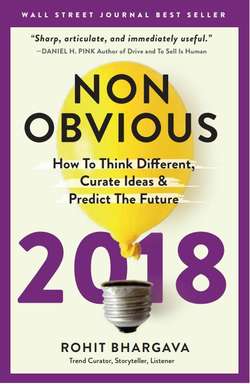Читать книгу Non-Obvious 2018 Edition - Рохит Бхаргава - Страница 73
На сайте Литреса книга снята с продажи.
The Art of Getting Trends Right (and Wrong)
ОглавлениеI shared Dan Gardner’s caution about the dangers of false certainty and skepticism about future predictions for a reason. If you are going to build your ability to curate trends, you must also embrace the idea that sometimes you will be wrong.
In Part IV, you will see a summary of previous trends along with a corresponding letter grade and a retrospective analysis of its longevity.
Some of them are embarrassingly off the mark.
The reason I share them candidly anyway is partly to illustrate Gardner’s point. I want to be as honest with you as I try to be with myself and my team after each year’s report. Foxes, after all, are comfortable with uncertainty and know they may sometimes be wrong. I know I’m sometimes wrong, and I guarantee that you will be, too.
Why write a book about predicting the trends and describe the entire process if we both might be wrong at the end of it? A fear of failure should not hold you back from applying your best thinking and exploring big ideas. More important, the Haystack Method may be a way to curate trends, but it’s also
a way to think about the world that involves finding more intersections and avoiding narrow-minded thinking.
Learning to predict the future, in other words, has a valuable side effect: it can make you more curious, observant, and understanding of the world around you. It’s this mental shift that may ultimately be the greatest benefit of learning to see and curate trends.
Oscar Wilde wrote that “to expect the unexpected shows a thoroughly modern intellect.”6 Non-Obvious is about helping you to build this type of modern intellect through noticing the things that others miss, thinking differently, and curating ideas to describe the accelerating present in new and unique ways.
Now that we’ve achieved that, let’s turn our attention to the trends for this year.
